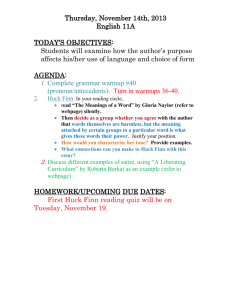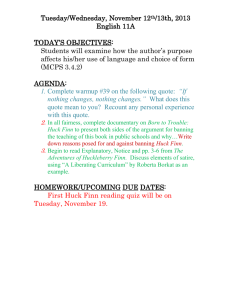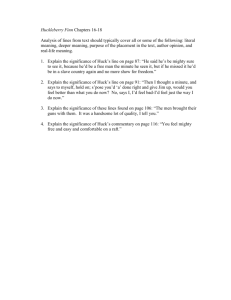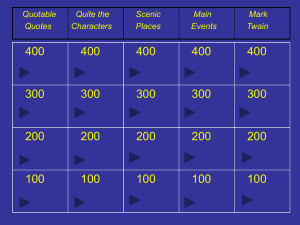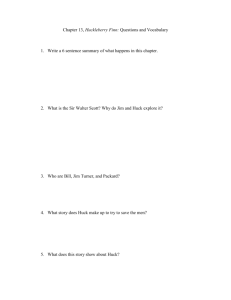Annotation Notes Complete
advertisement
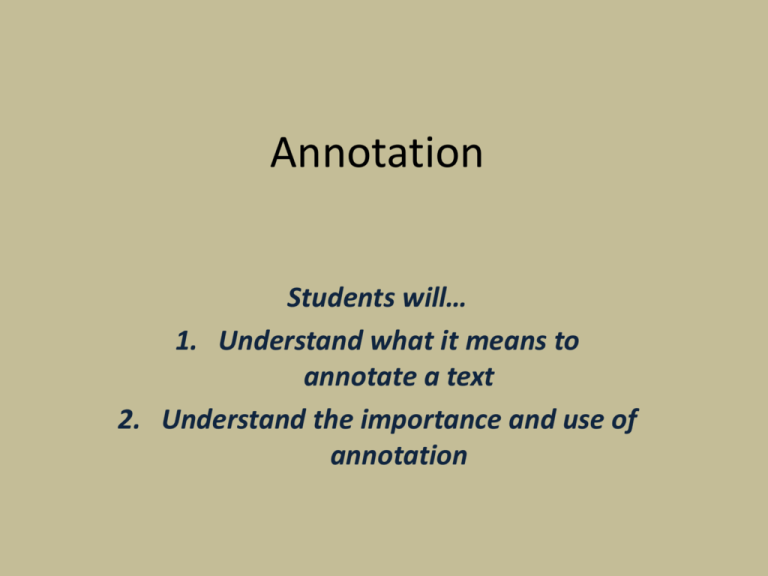
Annotation Students will… 1. Understand what it means to annotate a text 2. Understand the importance and use of annotation What is annotation? As an ACTIVE READER you should always be asking questions in your mind about the text. Annotation is a way to answer, and KEEP TRACK of, those questions as you read. What is the point of annotating? Annotations make it EASY TO FIND IMPORTANT INFORMATION quickly when you look back and review a text. They help you FAMILIARIZE YOURSELF with both the content and organization of what you read. They provide a way to begin THINKING ABOUT WHAT YOU ARE READING through comments, questions, associations, or other reactions that occur to you as you read. What does good annotation look like? A well-annotated text will accomplish all of the following: – clearly IDENTIFY where in the text IMPORTANT IDEAS and INFORMATION are located – express the MAIN IDEAS of a text – TRACE the development of IDEAS/ARGUMENTS throughout a text – Keep track of the reader’s (that’s you) THOUGHTS and REACTIONS T.A.P.S. A Good Place To Start If you’re having trouble figuring out how to begin annotation, remember TAPS… • • • • Topic: What is the topic of the text? Audience: To whom is the message directed? Purpose: What is the writer’s goal? Speaker: What can be inferred (assumed) about the speaker’s attitude toward the topic or the audience? What is the process? 1. Read through the text once 2. Circle unfamiliar vocabulary 3. Define any unfamiliar words Then… 4. Highlight/Underline • Highlighting is a good way of picking out SPECIFIC PARTS of a text that you may WANT TO CITE OR QUOTE. • Highlighting is a useful way of marking parts of a text that you want to MAKE NOTES ABOUT. • It’s a good idea to highlight the key WORDS OR PHRASES of a text. CAUTION! Over-reliance on Highlighting is unwise Be careful that you are not highlighting more information than necessary. This is why it is important to read through the text one time before picking up your highlighter! 5. Paraphrase/Summary of Main Ideas • It is not enough to just locate important ideas • You must be able to CAPTURE THEIR MEANING. • Paraphrasing is a way showing your UNDERSTANDING of these ideas. • It’s also excellent PREPARATION FOR ANY WRITING you may have to do based on your reading. Paraphrasing Continued… • You should be making a series of brief NOTES in the margins beside important ideas • This gives you a handy SUMMARY right on the pages of the text itself • (Note: to do this, you should condense a sentence or paragraph into a few words – this will demonstrate your understanding of the text) 6. Outlining • This is a “REVERSE” outline of sorts. • Rather than creating an outline ahead of writing, you’re going to make an outline of the piece of writing you are READING. • To do this, explain in one sentence (or less) what the FUNCTION of each paragraph is. The Author is… • • • • • • • • • Summarizing a topic/argument/etc. Introducing an idea Adding explanation Giving examples Providing facts/evidence Expanding the idea Considering an opposing view Dismissing an opposing view Stating a conclusion 7. Comments/Responses • Go beyond UNDERSTANDING a text’s MEANING and actually respond to it • What is your REACTION? – Agreement or disagreement? – Questions? – Connection to ideas from other texts, class discussions, etc? – Related personal experience? Step #1: Read through one time Step # 2: Identify unfamiliar vocabulary Step #3: Define unfamiliar vocabulary Upcoming NewSouth 'Huck Finn' Eliminate The 'N' Word By: Marc Schultz, Publishers Weekly Politically Correct Too PC? Mark Twain's Adventures of Huckleberry Finn is a classic by most any measure. T.S. Eliot called it a masterpiece, and Ernest Hemingway pronounced it the source of "all modern American literature." Yet, for decades, it has been disappearing from grade school curricula across the country, relegated to optional Down-graded reading lists, or banned outright, appearing again and again on lists of the nation's most challenged books, and all for its repeated use of Unusually a single, singularly offensive word. Step #4: Hi-light key words/ideas Step #5: Paraphrase Step #6: Outline Step #7: Comment Upcoming NewSouth 'Huck Finn' Eliminate The 'N' Word Why too PC? Will author answer this question? Good quote! Why did Huck start all modern Am. Lit? Not being taught. Also challenged, optional or banned By: Marc Schultz, Publishers Weekly Introduction – The author is introducing the controversy Too PC? Mark Twain's Adventures of Huckleberry Finn is a classic by most any measure T.S. Eliot called it a masterpiece, and Ernest Hemingway pronounced it the source of "all modern American literature." Yet, for decades, it has been disappearing from grade school curricula across the country, relegated to optional reading lists, or banned outright, appearing again and again on lists of the nation's most challenged books, and all for its repeated use of a single, singularly offensive word. Why “singularly”? What makes this an unusually offensive word? KEY: Outlining Paraphrasing Comments The main reason Huck is a problem. Your Turn! To Recap… Step 1: Read Step 2: Unfamiliar words/terms Step 3: Define words Step 4: Hi-light Step 5: Paraphrase Step 6: Outline Step 7: Comment
